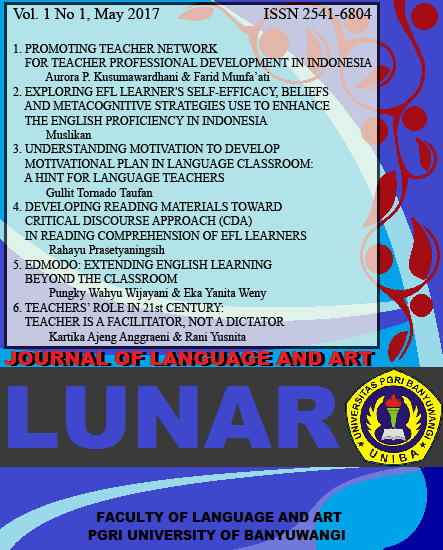UNDERSTANDING MOTIVATION TO DEVELOP MOTIVATIONAL PLAN IN LANGUAGE CLASSROOM: A HINT FOR LANGUAGE TEACHERS
Abstract
Motivation is considered as one of the key elements that lead to students’ success in L2 learning. Teacher’s role in building and maintaining motivating atmosphere inside the classroom is undoubtedly crucial. In this case, the teacher should understand what motivation is, how this influences students’ behavior, and what to do to help them motivated.
A motivational plan can be developed to help language teacher create and maintain motivating classroom conditions. Regarding this, there are four principle aspects to take into account including: creating the basic motivational conditions, generating initial student motivation, maintaining and protecting motivation, and encouraging positive retrospective self-evaluation.
References
Agustrianti, S., Cahyono, B.Y., Laksmi, E.D. 2016. Indonesian EFL Students’ Motivation in English Learning and Their Literacy Skills across Gender. International Journal of Applied Linguistics & English Literature. 5(4): 219-227.
Al Othman, F.H.M. & Suqhair, K.M. 2013. The Impact of Motivation on English Language Learning in the Gulf States. International Journal of Higher Education. 2(4): 123-130.
Astuti, S.P. 2015. Teachers’ and Students’ Perceptions of Motivational Teaching Strategies in an Indonesian High School Context, Unpublished Thesis.
Bahous, R., Bacha, N.N., & Nabhani, M. 2011. Motivating Students in the EFL Classroom: A Case Study of Perspectives. English Language Teaching. 4(3): 33-43.
Bernaus, M., Wilson, A., and Gardner, R.C. 2009. Teachers Motivation, Classroom Strategy Use, Students’ Motivation and Second Language Achievement. Porta Linguarum. 12:25-36.
Brown, H.D. 2000a. Principles of Language Learning and Teaching (4th Edition). New York: Longman.
Brown, H.D. 2000b. Teaching by Principles: An Interactive Approach to Language Pedagogy (2nd Edition). New York: Longman.
Cohen, A.D. 2010. Focus on the Language Learner: Styles, Strategies, and Motivation.(Online) Retrieved April 2, 2014 from https://sites.google.com/a/umn.edu/andrewdcohen/publications/language-learner-styles-strategies
Kassing, R.B. 2011. Perceptions of Motivational Teaching Strategies in an EFL Classroom: The Case of a Class in a Private University in Indonesia, Unpublished Thesis.
Lagasabaster, D. 2011. English Achievement and Student Motivation in CLIL and EFL Settings. Innovation in Language Learning and Teaching. 5(1): 3-18.
Lightbown, P.M. & Spada, N. (2013). How Languages are Learned (4th Edition). Oxford: Oxford University.
Muftah, M. & Rafik-Galea, S. 2013. Language Learning Motivation among Malaysian Pre-University Students. English Language Teaching. 6(3): 92-103.
Murtiana, R. 2010. Steps to Lift the Students’ Motivation in Learning English. LET Journal. 1
Ormrod, J.E. 2002.Essentials of Educational Psychology. Upper Saddle River: Pearson.
Ryan, R.M. & Deci, E.D. 2000. Intrinsic and Extrinsic Motivations: Classic Definitions and New Directions. Contemporary Educational Psychology. 5. 54-67.
Santrock, J.W. 2006. Educational Psychology: Classroom Update. New York: McGraw-Hill.
Saville-Troike, M. 2006. Introducing Second Language Acquisition. Cambridge: Cambridge University Press.
Ushida, E. 2005. The Role of Students’ Attitudes and Motivation in Second Language Learning in Online Language Courses. CALICO Journal. 23(1): 49-78.
Woolfolk, A. 2004. Educational psychology (9th Edition.). Boston: Allyn & Bacon.
Xiao, F. 2013. Motivational Strategies in Teaching English as Foreign Language – Applying Motivation Plan in TELF. International Journal of Humanities and Social Science. 4(18): 257-262.
Downloads
Published
How to Cite
Issue
Section
License
This work is licensed under a Creative Commons Attribution-ShareAlike 4.0 International License.



















